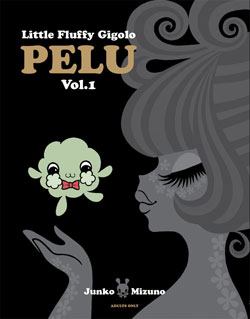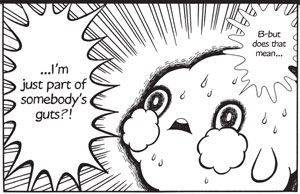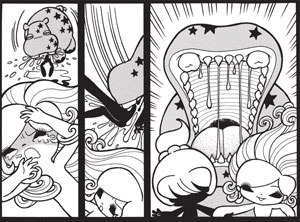 Logo handmade by Bannister
Column by Scott Green
Logo handmade by Bannister
Column by Scott Green
Junko Mizuno's irreverently grotesque design has adorned condoms and My Little Pony, she's about to make her impression on Spider-Man, and, recently, she's been at the epicenter of two significant highlights for Japanese pop culture in the US. This past weekend, she had a signing at newly opened, San Francisco based Japanese pop culture destination New People. For photos and coverage of the event, check out Same Hat! If you weren't in the area, the other Mizuno milestone is the release of the first of her three volume fractured fairytale Little Fluffy Gigolo PELU, published by Last Gasp and adapted by jaPRESS. To check out a preview of this story of an alien reproductive organ looking for love on Earth, or to pick up a copy, check out Last Gasp's site. AICN is fortunate to be able to share some of Junko Mizuno's thoughts on her work.

Scott Green: Little Fluffy Gigolo Pelu takes a mischievous approach to characters who often seem deeply unsatisfied. Do you have an emotional inspiration for writing these humorously bleak fairy tales?
Junko Mizuno: I take inspiration from many different things when I write stories, such as actual experiences friends or myself have had, movies, TV dramas, documentaries, novels, comics, etc. I remember that I took the idea of Pelu always being unlucky in love from the Tora-san movies, AKA Otoko wa Tsurai yo.
SG: Conversely, do you find the act of writing these stories to be personally provocative?
JM: I don't know... I just always try to write what I can enjoy.
SG: The three volume Little Fluffy Gigolo Pelu is significantly longer than your work on Pure Trance or other manga like Hansel & Gretel or Cinderella. How did Little Fluffy Gigolo Pelu's length influence the manga?
JM: Pelu was serialized in a monthly comic magazine and it was a very different experience from my previous comics. For Pure Trance and the three fairy tales, the stories were already finished when I started working on the art. But for Pelu, I had decided on the ending and kept making up the stories as I went on. As the serial lasted for over three years, the story wound up reflecting changes and growth over the course of my personal life.
SG: Could you share your thoughts on the San Francisco based Japanese popular culture complex, New People?
JM: Actually, I haven't visited the place yet. I'm looking forward to finally getting inside the building for my signing on Saturday 8/22.
SG: Speaking of the city, the biography in Little Fluffy Gigolo Pelu mentions that you are currently residing in San Francisco. What are your impressions of the area?
JM: The move hasn’t changed my lifestyle so much. I'm basically at home, working hard like I used to do in Tokyo. The best thing about San Francisco for me is the weather. It has become much easier for me to work as I don't need to suffer from changing temperatures anymore. People are nice and food is good here. I always wanted to try living in a foreign country and I'm enjoying it now!
SG: Beyond manga, your designs have appeared in numerous other media, such as t-shirts plushes or vinyl figures. Fans have even paid tribute to your illustrations with tattoos or scarification. Do you have a favorite, non-manga reproduction of one of your designs?
JM: It's hard to choose only one favorite. I enjoy all the products I design and I think of every one of them as my art.
Thank you to Junko Mizuno for sharing her thoughts and to Patrick Macias for helping with the interview. And, if you missed AICN's feature on Little Fluffy Gigolo Pelu ...

Manga Spotlight: Little Fluffy Gigolo Pelu Vol. 1 By Junko Mizuno Released by Last Gasp / jaPRESS
In an Indiana Jones movie, Spielberg would take a skeleton and accessorize it with something that would accentuate the shock value: blood, snakes, rats. For this conversation, swap the skeleton for a baby doll or other imagery that hugs onto the label "girly." I can't pin-point when that juxtaposition would be considered new, but I can attest to the fact that the concept has been productized and merchandised to the point where a 60 year old 2nd grade teacher can identify Emily the Strange and Gloomy Bear. That said, it is gratifying to observe that luminary Junko Mizuno is still bringing provocative innovation to the space. There's nothing staid in her chimera creation of Sanrio/Hello Kitty cherubic puff spliced with Hideshi Hino style nauseating grotesque. Her new Fluffy Gigolo Pelu suggests that her work is only veering into more vividly mischievous territory. It offers a look at an exercise that is comparable to taking the broken crumbs from the bottom of a bag of candy and trying to melt them into a lollipop - bright and supposedly sweet, but deformed and foul smelling where it's burned. Pelu's stories of alienation, unconventional pregnancy and huffing are overtly cracked, but the view that it presents of less incendiary subjects like office work dreariness and career dissatisfaction similarly fit into its scheme of candy colored unhappiness. Little Fluffy Gigolo Pelu finds Mizuno jumping onto the stack of voices to rework fairy tales. It occupies a place between Mizuno's fairy tales, published in English by Viz (Cinderalla, Hansel & Gretel, Princess Mermaid) and Pure Trance, published by Last Gasp. The former reimagined the classic European tales with zombies, yanki delinquents, dietary disasters and prostitution. The later was originally serialized across the booklets from a line of CD releases and lampooned a merchandise minded knick knack obsession with consumption. Its story followed saintly nurse Kaori Suzuki in her dedicated work to preserve the many women who harmed themselves through Pure Trance (covered here) related eating disorders. At the same time, the manga's panels, and even margins, were crowded with objects that succinctly presented an idea that was both eye catching and shocking, ready to be copied onto a t-shirt or realized as a three dimensional vinyl figure. From oral tradition, to writers and scholars like Hans Christian Andersen and the Brothers Grimm to Disney and Warner cartoons, fairy tales are bound to be profoundly marked by the last hand to touch them. Shoujo manga has had a long history of spinning a gender discussion out of the genre. Osamu Tezuka's proto-shoujo Princess Knight followed a girl, raised as a boy to protect her kingdoms throne, who adopts the third identity of the "Princess Knight" to fight for justice. These themes were later elaborated upon by the vanguard of women writing shoujo, including Riyoko Ikeda ( Rose of Versailles), Moto Hagio (They Were 11, To Terra) and the Year 24 Group. Mizuno's work puts a bear hug like violent embrace on shoujo. With Little Fluffy Gigolo Pelu returning to the idea of subverting a fairy tale, she is continuing to stack impressions onto the sediments laid down by other manga artists Little Fluffy Gigolo Pelu opens on the "cute and pink planet" Princess Kotobuki. It's a place that looks like what might pass before you're eyes in the sickness following a bender of Tequila and marshmallow peeps, the population of which is comprised of the beautiful women-like Princess Kotobukians, "a calm but carnivorous giant space hippo" and Pelu. As with other fairy kingdoms, Princess Kotobuki is in proximity to, but invisible from Earth. It's not just a disconcerting juxtaposition along the lines of Hansel and Gretel's Japanese youth toughs of the 70's meets Germanic stories. In Princess Kotobuki's abrupt detachment from the familiar, Little Fluffy Gigolo Pelu resembles Pure Trance. Beyond being the equivalent of a fairy kingdom, Princess Kotobuki also broadcasts Mizuno's sense of uber-feminine aesthetic. Imagine a planet of shirtless muscle guys from an MMA gym hitting each other... something out of Dragon Ball or the like... then reverse it. There's lots of nudity and gender identification, without much to titillate. For Pelu himself, as the song goes "he's not a cat, he's not a dog. He's an alien and his name is Pelu." Tragically, the knee high green cotton ball finds himself alienated from the Princess Kotobukians, because... spoilers... he's a reproductive organ. The revelation is inconceivable, even for a being that's used to listening to a hippo grouse about lightning storms. So, noting the diversity of Earth's population, Pelu leaps into a magic mirror hoping to find someone like himself. His mad anti-trip-to-Oz whirlwind is captured in a montage of dreary meetings, lottery wins, and over eating - framed by a psychedelic expectoration of bubbles. "He's not a cat, and he's not a dog. Forgive me mama, I'm going on a trip. I'll come back to Princess Kotobuki someday. With a beautiful bride at my side." So, after Following Sex Education on a Fantastic Planet, the first volume of Little Fluffy Gigolo Pelu launches into a series of fairy tales of a fabulized state of current affairs including The Naked Enka Singer The Sassy Girl and the Bad Boy Beach Maidens The Mysterious High School The pattern for the four latter stories is simple. Pelu shacks up with a needy young woman. He tries to make her happy. It goes disastrously awry, and he's forced to hit the road to the Pelu equivalent of the Lonely Man Theme. Well, maybe he's not entirely lonely. There is a transient who cuddles with Pelu between the ventures of attempting to help women find acceptance, love and fulfillment. In its mirth at Sisyphean bleakness, Little Fluffy Gigolo Pelu reminds me of one of my favorite manga - Toru Yamazaki's Octopus Girl. That title refers to a girl reborn as a sort of were octopus after being bullied to death by classmates. Along with her companion/rival Eel Girl, the pair pursue their dreams of beauty and adoration into horrific consequences. For example, with dreams of being the idol who commands the focus of tabloid covers, Octopus Girl enters a pageant. She puts stinging centipedes into the swim suit of one contestant (queue panel of a skin marked with horrific welts), then cuts off a bit of one of her fingers, drops it into another contestant glass of water, and allows it to become a tentacle when the other girl attempts to swallow (queue panel of girl choking on octo-tentacle). Our heroine is karmically rewarded when the plane taking her to Okinawa for a beach photo shoot crashes into the ocean. She survives thanks to her were-octopus existence, figures that with everyone likely believing she's dead, she's wasted her efforts, and with a bemused smile, she begins swimming back to Tokyo for another shot at appreciation. It's like reality TV desperation meets Kazuo Umezu gross-out horror. Little Fluffy Gigolo Pelu has Octopus Girl's MO of laughing at the disastrous consequences of misguided attempts at finding happiness. Pelu functions as the catalyst that brings these stories of unhappy young women to a climax, whether its the shellfish diver living in the sewer with her basket of robot arms or the chubby plain looking orphan, working her way through Shirley Temple High. For example, Pelu wanders past a poodle ranch into a wealthy area. He falls for the sparkling cute daughter of a best selling romance writer. With her mother forced to devote all of her attention to editors, the "Sassy Girl" has rebelled by falling for an easily distracted glue sniffing biker. Pelu allows her to briefly capture the guy's attention, but the puff ball fails to keep him interested or the girl happy for long. Pelu tries to make the teen happy by bringing her some booze. That works, but not as well as an appearance by the space hippo... Hungry Hungry Hippo + poodle ranch = unhappiness for all. The consequences are hilariously worse than you might imagine... in a Stand By Me campfire story kindof way. Where as Octopus Girl stories end with the girls nihilistically smiling and pushing towards the next grab at fame and addoration, Pelu's end with the guy huffing and crying rainbows. Jason Thompson's Manga: The Complete Guide notes that the term "manga" can be translated to "whimsical sketches." "Irresponsible pictures" is another translation commonly used by English speaking commentators. In keeping with that label, it's a medium that has produced more than its share of transgressive works over the years. Show an unprepared person a panel of "Little Fluffy Gigolo Pelu" and their reaction is likely to be along the lines of "weird! why is the girl with the Disney Princess hair covered with bandages and why is she feeding a bag of pills to the bunnies?" Though Mizuno is an emphatically visual story teller, you actually have to read Little Fluffy Gigolo Pelu to pick up on the affront - that it sets up an infinity effect of laughing at something terribly bleak, then feeling bad about finding mirth in sorrow, then laughing at the absurdity of it all, and so on. Mizuno can be a divisive creator. I believe that you do need to "get" her work to appreciate some of her manga. However, I don't believe that's the case here. Little Fluffy Gigolo Pelu features enough dire absurdity that it'll force you to laugh.

